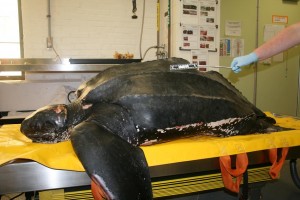
COURTESY OF THE NEW ENGLAND AQUARIUM
A Leatherback sea turtle that washed up dead on Sandy Neck Beach in Barnstable on Sunday suffered from a boat strike, ingesting plastic and an entanglement.
BARNSTABLE – An unlucky sea turtle that recently died in Cape Cod Bay suffered from a trifecta of man-made hazards.
The 400 pound juvenile Leatherback washed up on Sandy Neck Beach in Barnstable on Sunday.
A necropsy that was performed at the New England Aquarium’s sea turtle hospital in Quincy showed the animal was struck by a boat, filled with plastics and entangled in marine gear.
“We’ve never seen this with all three things on a single animal,” said Tony LaCasse,” a spokesman for the New England Aquarium. “He was a tough turtle but eventually he succumbed to getting caught in some type of vertical line, either going to a boat mooring or some kind of fishing gear.”
LaCasse said the turtle, remarkably, survived a boat strike early in the summer.
“The back piece of his shell and his back bone had a severe deformity that was very observable even from the outside,” he said. “But he actually had bone grow and hadn’t had an infection and was able to forage through much of the summer and he had a big layer of fat on him.”
The plastic items in his stomach were not found until a full necropsy was performed.
“There were candy bar wrappers in there as well as zip lock bags,” LaCasse said.
The turtle also swallowed a 3 foot by 1 foot sheet of plastic that is commonly used to wrap shingles.
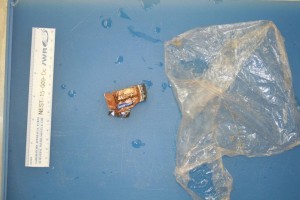
Smaller pieces of plastic found in the turtle’s stomach.
“Plastics are so durable that when they get out onto the ocean they float and ungulate a lot like sea jellies or jelly fish,” he said. “And that’s what these particular turtles eat, primarily.”
The veterinarian felt that the turtle may have been able to pass the smaller pieces of plastic but the long sheet would have never been passed. “And eventually, that would probably have led to some type of intestinal obstruction and would have killed him.”
LaCasse said there are steps that can be taken to try to prevent sea turtles from suffering from any one of these hazards.
“In terms of plastics ingestion, whether it’s in sea birds, whether it’s in whales and turtles, we need to be able to secure our trash particularly near the seashore,” LaCasse said. “We need trash cans that are along and around the seashore to have covers on them because we have all seen that experience of gulls pulling trash out from them.”
Researches have already seen a decline in the number of boat strikes on large sea turtles by recreational boaters over the last few years, according to LaCasse.
“That’s because there is more information and more education out there among boaters to go slow in those area that we know the Leatherbacks will be around in June and July,” he said. “Seeing a multi-hundred pound sea turtle will always be much more exciting then clipping along the waves at a high speed.”
LaCasse said more money is needed for research to find out how well the sea turtles see in the water to be able to cut down on the entanglements.
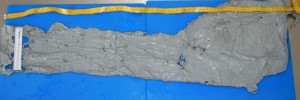
A large piece of plastic also found in the turtle’s stomach during the necropsy.
“We don’t know much about the visual acuity of sea turtles,” he said. “It could be something as simple as finding a color pattern that they are able to discern more readily.”
Limiting the number of vertical lines in the water during this time of year could also help to prevent entanglements.
LaCasse said there are currently hundreds of Leatherback turtles, which average about 700 pounds, migrating through the waters around the Cape.
“This particular sea turtle, the Leatherbacks, are not the ones that are subject to the cold stunning,” he said.
The Leatherbacks have the unique ability to raise their body temperature like mammals.
“They are able to stay longer and get out of the cold water,” LaCasse said. “And where most sea turtles don’t go much north of the Cape, these guys go all the way up to the Maritime Provinces in Canada.”
LaCasse said we should have a greater awareness of the Leatherback’s and enjoy the fact that they are here.
By BRIAN MERCHANT, CapeCod.com NewsCenter




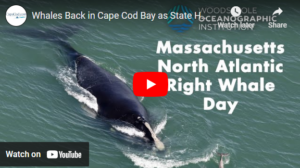




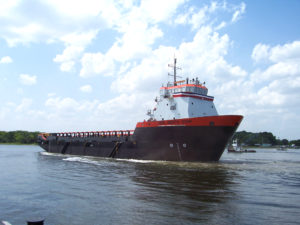


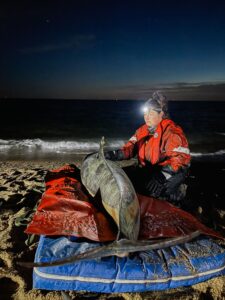
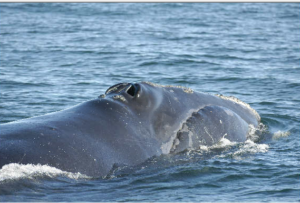










Undulate